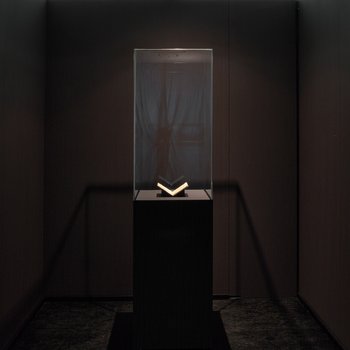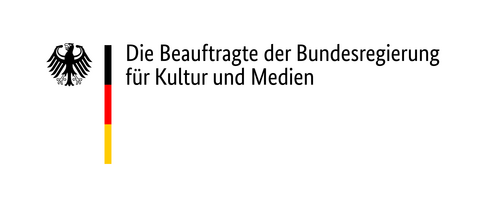Lotte Reiniger's Silhouette Figures
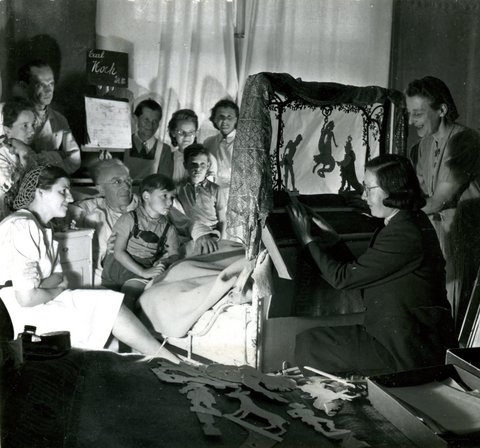
Puppeteer Elsbeth Schulz performing a shadow play at the bedside of Carl Koch (Lotte Reiniger's husband) in 1947. Nurses and children look on. Lotte Reiniger herself can be seen on the far right, playing the character of the King - From the album “Buch der Erinnerungen 1956-1960” by Elsbeth Schulz.
© Staatliche Kunstsammlungen Dresden, Puppentheatersammlung (Inv.-Nr.: C 13429_52)
The Berlin-based silhouette artist Lotte Reiniger (1899-1981) was one of the most important people in the history of shadow puppetry and animated film. As early as 1926 - more than ten years before Disney's SNOW WHITE AND THE SEVEN DWARVES (HAND, USA: 1937) - she made the world's first feature-length animated film: DIE ABENTEUER DES PRINZEN ACHMED (The Adventures of Prince Achmed) (Reiniger, Germany: 1926).
![[Translate to English:] Lotte Reiniger auf dem Internationalen Festival und IX. UNIMA-Kongress in München [Translate to English:] Lotte Reiniger auf dem Internationalen Festival und IX. UNIMA-Kongress in München](/fileadmin/_processed_/8/2/csm_F_45_28_1_3bb3d151a9.jpg)
Carl Schröder: Lotte Reiniger at the International Festival and IX. UNIMA-Congress in Munich (1966), 6 x 6 cm
© Staatliche Kunstsammlungen Dresden, Puppentheatersammlung (Inv.-Nr.: F 45,28)
![The Adventures Of Prince Achmed (1926) | Lotte Reiniger | 4K Remastered [FULL MOVIE] The Adventures Of Prince Achmed (1926) | Lotte Reiniger | 4K Remastered [FULL MOVIE]](/fileadmin/_processed_/3/2/csm_The_Adventures_Of_Prince_Achmed__1926____Lotte_Reiniger___4K_Remastered__FULL_MOVIE__a3a11519d0.png)
Inspired by her parents, who were interested in art and culture, Reiniger was already enthusiastic about fairy tales, theatre and creative design as a child. She developed shadow theatre at an early age and fascinated her family and schoolmates with her paper cuttings. Through the well-known theatre actor and film director Paul Wegener (DER GOLEM, WIE ER IN DIE WELT KAM (Wegener/Boese, D: 1920)), with whom she later became close friends, she came to the ‘Institut für Kulturforschung’, a studio for experimental animated films in Berlin. There she refined her techniques, especially silhouettes, and met Carl Koch. He became her husband and technical supporter. The couple were friends with numerous artists and well-known personalities in Berlin, such as the experimental filmmaker Walter Ruttmann and the playwright Bertolt Brecht.
Many of Reiniger's films are based on fantastical stories, fairy tales and myths. These include ASCHENPUTTEL (D: 1922), DOKTOR DOLITTLE UND SEINE TIERE (D: 1928) and PAPAGENO (D: 1935), in which, as almost always, she was responsible for both the direction and the animation. This also applies to DIE ABENTEUER DES PRINZEN ACHMED.
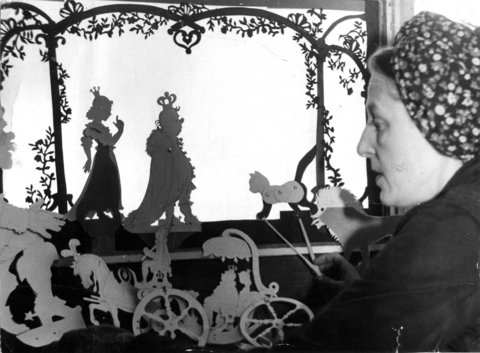
Lotte Reiniger performing behind the stage, scene from “Puss in Boots” (around 1947)
© Staatliche Kunstsammlungen Dresden, Puppentheatersammlung
The images for the film were captured using a special technique: Reiniger first made elaborate backdrops out of tracing paper and cardboard. She then placed the backdrop pieces between two glass plates. She then positioned the moving figures on the upper glass plate. Once she was satisfied with the interplay between the backdrop and the figures, she placed a light source below the glass panels and a camera above to record the production frame by frame. With financial support from the banker Louis Hagen, Reiniger recorded a total of 300,000 individual images of silhouettes for DIE ABENTEUER DES PRINZEN ACHMED in this way - an absolute feat in this quantity.
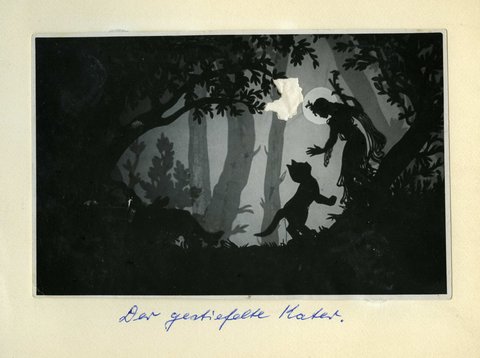
Album photo of "Der gestiefelte Kater" by Lotte Reiniger in cooperation with Elsbeth Schulz in 1947 at the Berlin 'Schattenbühne'
© Staatliche Kunstsammlungen Dresden, Puppentheatersammlung (Inv.-Nr.: 21784,6)
After the National Socialists seized power, she emigrated in 1935 and lived in London, Rome and Paris, where she also occasionally made advertising and informative films. One of the highlights of her career was the fairy tale film DAS TAPFERE SCHNEIDERLEIN (GB: 1955), with which she won the prize for best short film at the Venice Biennale. By the time of her death, Reiniger had produced over 80 films, making a significant contribution to the recognition of papercutting as an art form. From shadow theatre to papercutting and finally to animated film, she never lost her love for ‘silhouette theatre’, as she preferred to call it, and created figures for it over many years. The tomcat, which can be seen here as a 3D object, is not from an animated film production, but from the theatre play "Der gestiefelte Kater" (around 1947).

View of the stage of "Brüderchen und Schwesterchen", 1948
© Staatliche Kunstsammlungen Dresden, Puppentheatersammlung
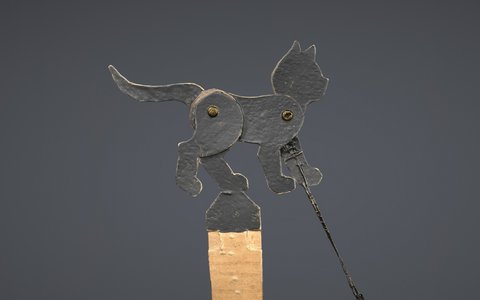
Photogrammetric 3D model of the cat from ‘Der gestiefelte Kater’ by Lotte Reiniger (1947)
© Staatliche Kunstsammlungen Dresden, Puppentheatersammlung (Inv.-Nr.: A 9103), 3D-Modell: Jacob Franke
“Der gestiefelte Kater” was performed by Elsbeth Schulz (1908-2001) - with the figures created by Lotte Reiniger. Schulz was initially a childcare worker before turning to puppetry in 1940 and shadow theatre in 1946. The cat puppet consists of a cardboard body that is coloured black on both sides. The movable body parts are connected at two points with swivel joints. A guide rod attached to the shoulder enables the front paws and head to be controlled. Another control rod has been attached to the back of the figure. One of the hind legs has been converted into a support and reinforced with an additional layer of cardboard at the bottom.
It remains uncertain whether Lotte Reiniger was actively involved in the performance of the play and the playing of the puppet, but it is rather unlikely. The figure and the stage set of Elsbeth Schulz's theatre as well as numerous stage sets and other figures were acquired by the Puppentheatersammlung in 1975.
Keep Reading:
What declares itself to be nonsense declares itself to be harmless. Supposedly. Because the consequence of such self-determination is the famous jester's license, which a group of theater people in the GDR also claimed for themselves in the 1980s when they called themselves “Zinnober” and began making Punch and Judy shows for adults. Their play “Die Jäger des verlorenen Verstandes” (Raiders of the Lost Mind) can easily be read by the audience as a mockery of the GDR state system and its toleration is hard to believe in retrospect - but true.
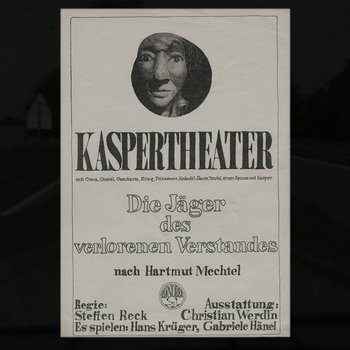
In the spring of 2020, a very special troupe of brightly coloured figures took up residence in the depot of the Puppentheatersammlung. Fishers and farmers, musicians and child gymnasts, not to mention ducks, water buffalos, dragons and fairies. They all belong to the classic cast of Vietnamese water puppetry.
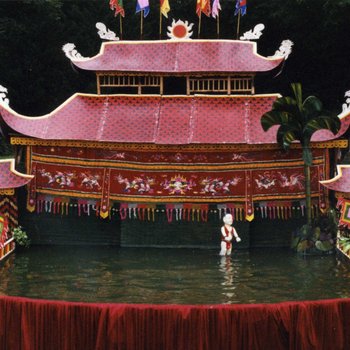
What do the Friedrich-paintings Das Große Gehege (The Great Enclosure) (1832), Hünengrab im Schnee (Dolmen in the Snow) (1807), Abtei im Eichwald (Abbey in the Oak Wood) (1818), Frau vor der untergehenden Sonne (Woman in Front oft the Setting Sun) (1818) and Nordische Landschaft/Frühling (Northern Landscape/Spring) (1825) have in common? Correct, they all include motifs recorded by Caspar David Friedrich between April and June of 1804 in a booklet, which is called the "Karlsruhe Sketchbook" today. Here you can flip through it.
